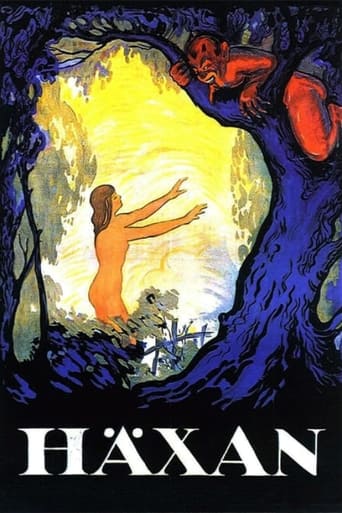

I've been meaning to watch this movie for awhile, but I finally got around to it and was very pleased with it. I watched it with my friend and we were both impressed with the special effects, the makeup, and the creative sets for being filmed in the 1920's. It would be a great film to watch around Halloween. If you watch the original version (which is what I would recommend) the film is told in 7 parts. The first part is explaining the universe with old school pictures of the solar system, then it becomes a documentary about witches and the hysteria in the Middle Ages about accusing innocent people with being in cahoots with the Devil. The music throughout the film is a little off because it's upbeat jazz music while the movie is creepy and grotesque. If you're interested in old school silent horror films about witchcraft, I highly recommend HAXAN!!!
... View MoreWell this is more a piece of documentary and lecture about witches and witchcraft than an actual movie with a story. Sure there are sequences with narrative elements but their only purpose is to show the audience how during Middle Ages people looked upon the unknown which was labeled quickly as witchcraft. The story is told in 7 chapters of which the first only consists of texts and drawings explaining things. Interesting without doubt but it felt much like being schooled. The next chapters shows us concrete situations with actors and a great setting. Images are shown of the bad things that witches would do, how they brew potions, how they were flying on broomsticks and celebrating in the woods with devils. The fantasy aspects were pretty impressive even though it's obvious the devils are wearing suits, yet the horns, tail, sharp claws and teeth it's all there. Much attention goes to how innocent people were accused of witchcraft, how they were tortured (the instruments really look gruesome) and thus forced into a confession. In the end there is also made a connection with the current time (which is 1922) which I thought was a bit off. Nevertheless an enjoyable piece of cinema even if it's only for a one time view.
... View MoreThis is an interesting documentary for those that are not really familiar with the history of witchcraft and enjoyable to watch for those of us already familiar with this part of world history.If you see the English narration by William S. Burroughs you will still need to read in parts of the film - the parts where it is a silent film with intertitles (the words on screen).The last 15 to 20 minutes of the film is the best part I believe. It is explain the painful torture the "witches" had to endure. Also explained is the "contagious madness" people, including nuns, participated in or witnessed.All in all anyone interested "Witches" and "Witchcraft" should view this film, IMO.8/10
... View More"Haxan," Benjamin Christensen's docudrama about the history of witchcraft in Europe, remains relevant more than 90 years after it was made because the subject is still alive in the public imagination and the artistry evident in some of the scenes transcends eras. The first part is taken up by a ponderous slide show, mostly of woodcuts, alternating with explanatory titles; in some cases an off-screen hand holds a pencil point to a detail of the image for emphasis. In silent cinema, of course, there can be no narration, so the title insertions take up a lot of running time. Once the introductory show-and-tell is over, we are treated to vividly photographed and sensitively acted dramatizations, mostly set in medieval times, of actual or suspected witches in action: shriveled old women who concoct potions from such unsavory ingredients as dead men's fingers or various animal parts; or innocent women who are in the wrong place at the wrong time and are falsely accused, then, under torture, falsely accuse others. The devil (played by Christensen himself) is depicted as a leering pointy-eared bald man with spindly clawed hands who is fond of perpetrating such outrages as sticking out his tongue, holding nocturnal orgiastic dance parties in forests, desecrating holy sites or bewitching unsuspecting nuns. The close-ups of vulnerable, aged women under interrogation are unsettling. The later films of Dreyer, particularly "The Passion of Jeanne D'Arc" and "Day of Wrath," come to mind. Sometimes the director breaks the flow by showing an actress on set toying with a thumbscrew prop, or by inserting titles describing what various cast members thought privately about witches and demons. Toward the end Christensen makes a didactic comparison of behaviors or characteristics which in former times would have been considered witchery but in modern times are given different labels: "materialism" (fondness for jewelry, for instance) or "mental illness," which at the time of this film was treated with hydrotherapy (showers) but in olden days could be considered evidence of demonic possession and result in burning at the stake.
... View More